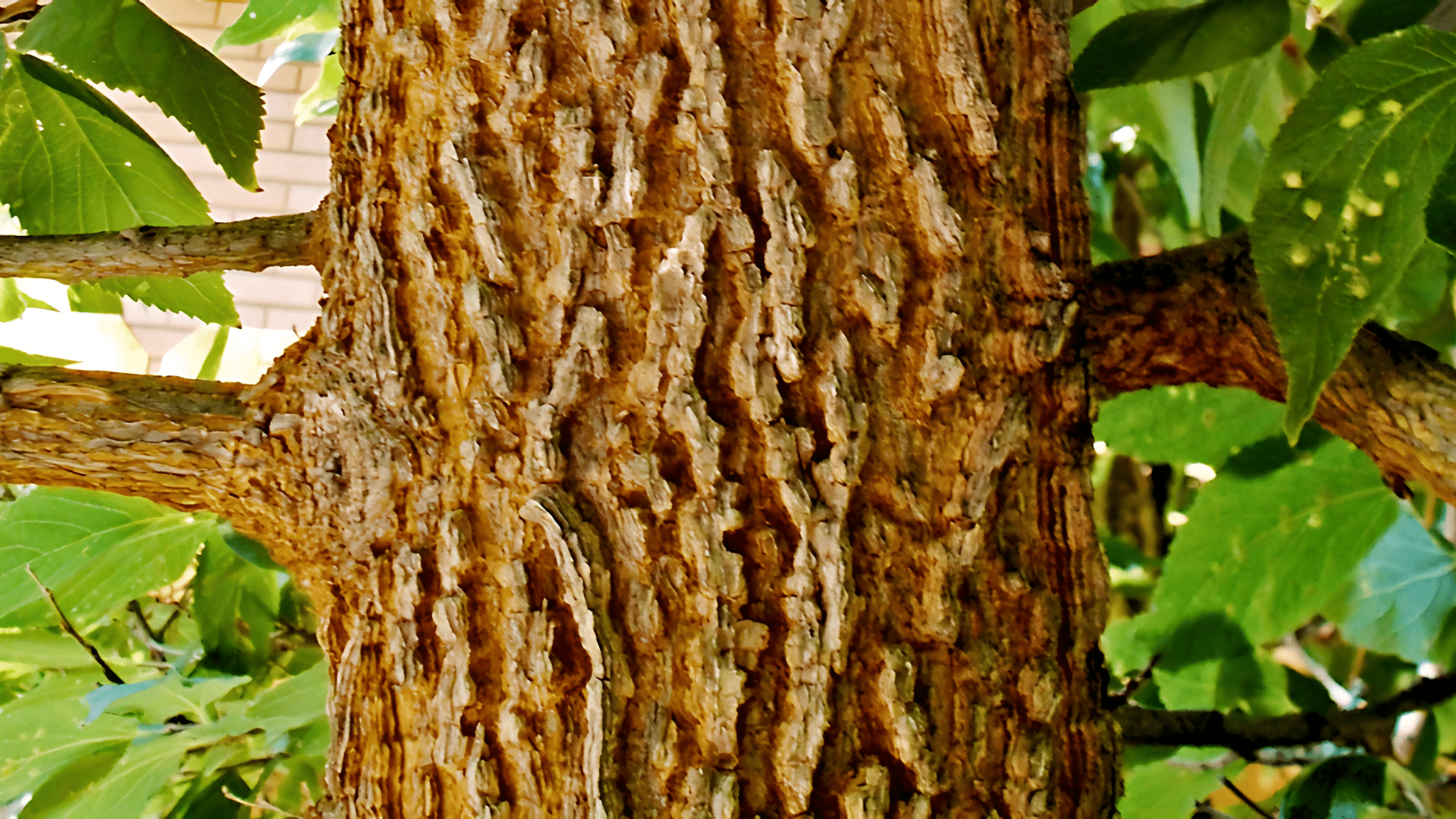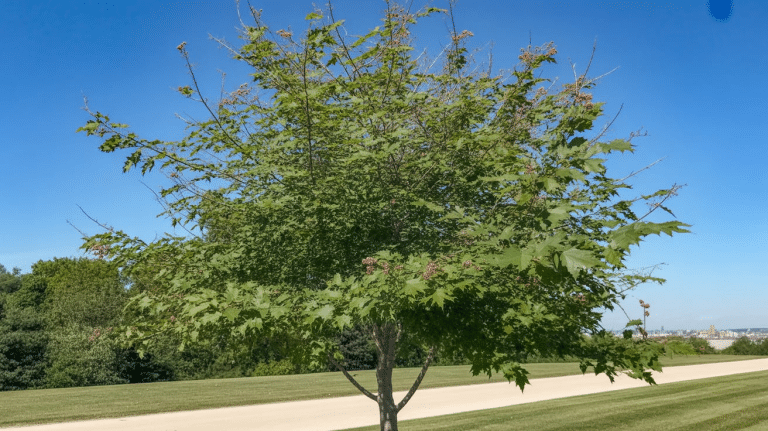Have you ever noticed a tree with bark that looks a little like popcorn and stands tough through every season? That’s a hackberry.
I used to walk past these trees without giving them much thought, but now I see just how much they contribute to a yard or park.
In this guide, you’ll learn how to spot a hackberry, understand its best and worst qualities, and find out how to grow one yourself.
I’ll also share care tips, simple steps for planting, common pests, and the ways this tree supports wildlife. If you’re curious about adding a reliable, native tree to your space, this guide is for you.
What is a Hackberry Tree?
The Hackberry (Celtis occidentalis) is a native tree found across much of North America. It’s valued for its toughness, quick growth, and support for wildlife.
Here’s a quick facts table to get you started:
| Feature | Details |
|---|---|
| Size | 60–80 feet tall, 40–50 feet wide |
| Lifespan | 150–200 years |
| Native Range | Eastern and central North America |
| Growth Rate | 1–2 feet per year |
Hackberry trees have upright, spreading branches and an oval or vase-shaped crown. Their bark stands out, often covered in corky ridges or “popcorn” bumps.
They make great shade trees and are well-suited to a range of soils and growing conditions.
Popular Varieties
Several improved varieties exist:
- Prairie Pride: Chosen for better leaves and disease resistance.
- Chicagoland, Delta, Windy City: Selected for growth form or faster growth.
- Prairie Sentinel: Narrower trunk for tight spaces.
Pros of Hackberry Tree
Hackberry trees offer several helpful qualities that make them a strong choice for yards, parks, and city spaces. Below are some of the key reasons people choose this tree.
Grows Fast
- The hackberry grows about 1 to 2 feet each year.
- That means it gives shade quicker than many other trees.
- Good if you’re starting a new yard or want fast coverage.
Very Tough
- It can handle hot summers, strong winds, dry weather, and even poor soil.
- You don’t have to worry much about watering or soil quality.
- This makes it a good pick for places where other trees might not grow well.
Great for Wildlife
- The tree makes berries that birds like to eat, especially in fall and winter.
- Its branches give birds a place to rest, nest, and stay safe.
- Some small animals use the tree for shelter, too.
Cons of Hackberry Tree
While hackberry trees have many good qualities, they also come with a few downsides that are worth knowing before you plant one.
Weak Branches
- Some limbs can be thin or not strong enough.
- In strong wind or heavy snow, these might break off.
- You’ll need to trim the tree when it’s young to help it grow stronger and avoid breakage later.
Leaf Problems
- The tree may get leaf spots (caused by fungus) or galls (caused by tiny bugs).
- These don’t usually hurt the tree, but they can make the leaves look bad.
- If you care a lot about how your yard looks, this might be a small issue.
Uses of Hackberry Tree
Hackberry trees offer a wide range of benefits, from practical landscaping uses to supporting wildlife and traditional purposes.
Below are some of the most common ways people use this tough and reliable tree.
1. Shade, Strength, and City Use
Hackberry trees are a solid choice if you want shade, wildlife support, and durability in one plant.
They grow tall with wide canopies, which makes them great for cooling down yards, lining streets, or creating windbreaks.
Because they grow fast and are low-maintenance, they’re often chosen for both private yards and public spaces.
City planners often choose hackberry trees for sidewalks, highways, and medians.
They can handle air pollution and soil compaction better than many other types of trees, which makes them ideal for busy or paved areas. Their strength and tolerance make them a favorite in urban settings.
2. Bark, Berries, and Wildlife
The bark of the hackberry tree has a rough, corky texture that gives the tree a unique look, especially in winter when the leaves are gone.
The tree produces small berries that ripen in the fall and stay through winter. Birds rely on these berries during colder months when other food sources are gone.
Hackberry trees also support native insects. Butterflies lay their eggs on the leaves, and the caterpillars feed on them. This makes the tree an important part of the local food chain, helping both pollinators and birds.
3. Traditional and Practical Uses
Hackberries were once used by Native American tribes for food. The berries were sometimes eaten raw, added to meals, or crushed into simple cakes. The bark was steeped in water to make a type of tea.
Today, the wood from hackberry trees is sometimes used for crates, firewood, or low-cost furniture. It’s not considered a top-grade hardwood, but it’s easy to cut and strong enough for everyday jobs.
For anyone looking to plant a tree that’s useful, dependable, and good for the environment, hackberry checks all the boxes, with very little maintenance.
How to Identify a Hackberry Tree

- Bark: Look for light gray or brown bark with distinctive ridges or “popcorn” warts. Young trees start smooth but get bumpier with age.
- Leaves: Simple, alternate leaves, 2–5 inches long, with uneven bases and toothed edges. Leaves turn yellow in fall.
- Flowers: Small, green, and not showy, these appear in spring for only a couple of weeks.
- Fruit: Round, reddish-purple berries about ½ inch across. They ripen by late summer and often stay on the tree into winter.
- Roots: Deep and wide-reaching, adapting to different soil types.
How to Grow Hackberry
Hackberry is a hardy tree that grows fast, adapts to tough soil, and supports local wildlife. You can plant a young tree from a nursery or grow your own from seed or cuttings, depending on what you prefer.
Start by picking a sunny spot with well-draining soil. Hackberry trees do well in clay, sand, or rocky ground, as long as water doesn’t collect.
When planting, dig a wide hole, place the tree at ground level, water well, and add mulch to hold moisture and block weeds.
During the first season, water your tree once a week. After that, once it’s established, you can water it less. Prune in late fall or winter to shape the tree and remove weak or damaged branches.
If you want to grow a hackberry from seed, cold-stratify the seeds in the fridge for 90 days before planting in moist soil. For cuttings, take healthy spring growth and root it in a damp mix. Both methods are slow but doable with some care.
Most seeds sprout well after their cold period. Just make sure the containers don’t freeze solid while you wait. A little protection during this time can make a big difference.
If you plant a nursery tree or grow one from seed, hackberry is simple and rewarding to grow. With a bit of care, you’ll have a fast-growing, tough tree that gives shade, beauty, and supports birds and insects for years to come.
Common Pests and Problems with Hackberry Tree
- Galls cause small lumps on leaves, but only affect appearance
- Witches broom creates tight twig clusters and can be pruned as needed
- Beetles attack weak or dead branches and rarely cause serious damage
- Leaf spots are fungal and look bad, but don’t harm the tree
- Hackberry nipple gall forms bumps on leaves and is mostly harmless
- Powdery mildew appears as a white coating and has little impact
- Scale insects feed on sap and may weaken the tree over time
- Aphids leave sticky residue and attract ants, but are not severe
- Root rot can occur in soggy soil and may stunt growth
Summing Up
I hope you feel more confident about what a hackberry tree brings to your yard. You now know how to spot one, understand the best and worst parts, and help it grow strong for years.
We looked at care, planting steps, and how this tree helps birds and other wildlife.
Even though hackberry is not flashy, it’s a steady pick for those who want something reliable and full of life.
If you want advice for choosing trees or caring for your landscape, take a look at other blogs on our site.













